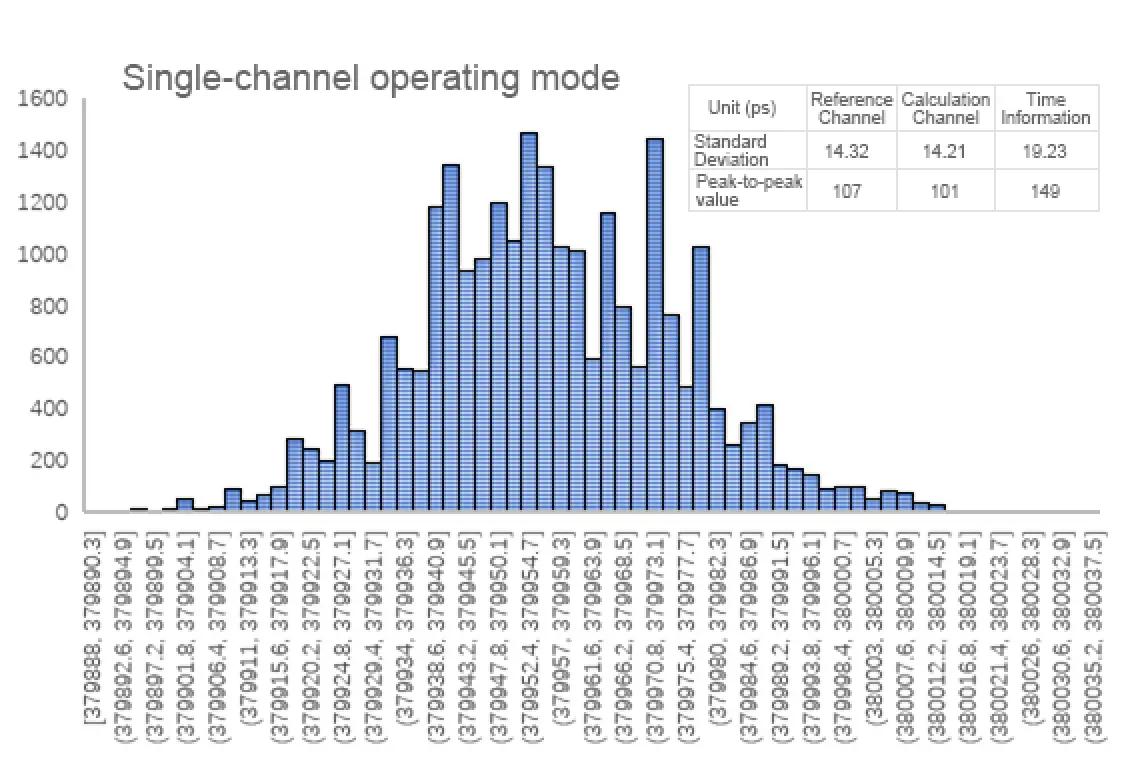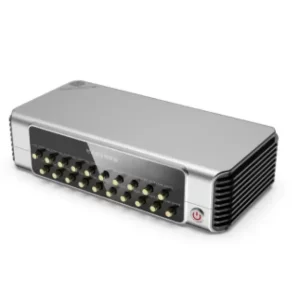Introduction: What is a Time-to-Digital Converter?
A Time-to-Digital Converter (TDC) is an essential instrument for high-precision time interval measurements. It converts the time difference between two electronic events into a digital value, typically measured in picoseconds (ps). TDCs are critical in fields where nanosecond or sub-nanosecond timing is required, such as in LiDAR, fluorescence lifetime imaging (FLIM), quantum optics, and time-correlated single-photon counting (TCSPC).
How TDCs Work
TDCs function similarly to stopwatches at the nanoscale. They measure the interval between a “start” and a “stop” signal using a fast internal clock or delay line structure. The key components and parameters include:
- Resolution: The smallest distinguishable time step. Sub-10 ps resolution means extremely fine granularity.
- Jitter: Random variation in the timing measurement. Lower jitter means more consistent results.
- Dead time: The minimum time between two valid measurements. Short dead times enable high throughput.
- Multi-channel support: Many applications need multiple channels to time-tag photons or events in parallel.
TDCs are often implemented in FPGA-based systems with parallel counters or delay interpolators to achieve high speed and low jitter.
16-Channel High-Precision Time-to-Digital Converter – QTDC-16CH-0A
The QTDC-16CH-0A is a compact, high-performance time-to-digital converter (TDC) designed for photon-timing and correlation applications. Featuring 16 independent input channels, it records the arrival times of photon pulses with sub-10-picosecond precision. The QTDC-16CH-0A can build on-board histograms or output raw time-tags, and supports flexible timing computations (e.g. programmable time-coincidence windows) on the FPGA. It provides dual high-speed readout interfaces (10‑Gigabit Ethernet with UDP protocol and USB 3.0) for burst transfers or time-tag streaming. This combination of high channel count, fine time resolution and fast data links makes the QTDC-16CH-0A well suited for demanding scientific experiments such as LiDAR, quantum optics and time-correlated single-photon counting.
Key Specifications and Features
- 16 simultaneous channels: Each channel timestamps incoming pulses independently (SMA, 50 Ω inputs). Multiple channels can be used in coincidence or independently.
- Sub-10 ps resolution: The basic time-bin width is under 10 ps (user-configurable, related to operating mode). Timing precision (RMS) is guaranteed ≤20 ps, ensuring ultrafine timing measurements.
- Very low jitter: The instrument’s intrinsic time uncertainty (jitter) is specified below 20 ps, consistent with the measured standard deviations (~10–20 ps) in single- and dual-channel modes (see Fig. 1 and Fig. 2).
- High event rate: Each channel can sustain pulse rates up to 20 million counts per second, so it can capture high-speed photon streams without saturation.
- Fast data interfaces: Processed histograms and/or raw event data can be offloaded via 10 Gigabit Ethernet (UDP) or USB 3.0. The Ethernet link uses a lightweight UDP packet format for streaming time-tags or histogram bins in real time.
- Flexible histogramming: On-board FPGA firmware supports configurable histogramming. Users can select histogram bin widths (e.g. powers of 2 in picoseconds) and up to 4 concurrent histogram channels, or request raw time-tag output for custom post-processing.
- Environmental robustness: The QTDC-16CH-0A is built into a robust enclosure (≤20×15×5 cm) and operates over a wide temperature range (–40 °C to +125 °C), making it suitable for laboratory and field use.
These features together enable precise multi-channel time measurements. In practice, the QTDC-16CH-0A achieves timing stability and resolution on par with high-end TCSPC instruments. For example, the device’s sub-10 ps time binning and low differential nonlinearity match the precision needed to resolve ultrafast optical signals.
Performance Demonstration
The QTDC-16CH-0A’s timing performance can be illustrated by example histograms of photon arrival differences. In single-channel mode (one channel compared to a reference), the measured timing distribution has a full-width on the order of 100–150 ps and an RMS jitter on the order of 15–20 ps.


These results show that the QTDC-16CH-0A delivers extremely fine time stamping. The on-board digital hardware (FPGA-based TDC) ensures minimal differential non-linearity and fixed timing skew between channels, so multi-channel coincidence and correlation histograms can be accumulated with very high fidelity. In practice, engineers can rely on the device’s specifications (<10 ps bins, <20 ps jitter, 20 Mcps rate) when designing experiments in photon counting and time-correlation.
Common Applications
The QTDC-16CH-0A is designed for applications where sub-nanosecond time precision and multiple channels are required. Representative use cases include:
- LiDAR and Time-of-Flight Imaging: By timestamping returned photons from a pulsed laser, the QTDC enables millimeter-scale depth resolution over long ranges. Its 16 channels can read out multiple laser returns or detectors in parallel. The device’s 20 Mcps per-channel rate accommodates high-repetition laser LiDAR systems, and its fine timing resolution (<10 ps) translates to sub-millimeter range precision.
- Quantum Optics & Communication: Experiments in quantum optics often require measuring coincidences between single-photon detectors. The QTDC’s multi-channel inputs and ultra-low timing jitter allow tight coincidence windows for entanglement or photon-correlation measurements. Its low dead time and FPGA coincidence logic are ideal for quantum key distribution and correlated-photon studies.
- Time-Correlated Single-Photon Counting (TCSPC): In TCSPC, the arrival times of photons (typically fluorescence or luminescence) are histogrammed relative to an excitation trigger. The QTDC-16CH-0A can perform on-board histogramming of photon arrival differences or stream time-tags for offline histogramming. Its picosecond binning and high throughput support fast accumulation of decay curves. (TCSPC is a standard method for measuring fluorescence lifetimes.)
- Fluorescence Lifetime Imaging Microscopy (FLIM): FLIM requires mapping fluorescence decay times across an image. The QTDC’s fine timing resolution and 16 channels (e.g. combining signals from pixelated detectors or scanning systems) yield high-quality lifetime data. Ultra-low jitter and high event rate ensure that lifetime histograms are built with high temporal precision.
In all these cases, the QTDC-16CH-0A complements single-photon detectors (SPADs, PMTs, etc.) by providing the timing engine. Its dual data interfaces (USB3.0 and 10GbE) also make it suitable for integration into modern data-acquisition frameworks, including real-time processing on GPUs or FPGAs via the Ethernet output.
Compared to other commercial photon-timing modules, the QTDC-16CH-0A offers a competitive mix of resolution, channel count and bandwidth. The table below compares its key specs with two well-known high-end TDC systems: PicoQuant’s HydraHarp 400 and ID Quantique’s ID900 Time Controller.
Product | Time Resolution | Timing Jitter (RMS) | Max Rate (per ch) | Channels | Data Interface |
QTDC-16CH-0A | <10 ps | ≤20 ps | 20 Mcps | 16 | 10 Gb Ethernet (UDP), USB 3.0 |
HydraHarp 400 | 1 ps | <12 ps | 12.5 Mcps | up to 8 | USB 3.0 |
ID Quantique ID900 | 13 ps | ~6 ps (high-res mode) | ~100 Mcps (processing) | 4 (input) | 10 Gb Ethernet |
All three systems achieve picosecond timing. The HydraHarp 400 offers the finest binning (1 ps) and operates up to 8 channels via USB3.0, making it a TCSPC workhorse. The ID900 provides a versatile four-channel platform (with delay-generator outputs) and can process up to ~100 million events/s per channel on-board. The QTDC-16CH-0A distinguishes itself with 16 channels and dual high-speed interfaces. Its <10 ps bin width and ≤20 ps jitter put it in the same class of precision, while its 20 Mcps/channel rate is higher than the HydraHarp’s 12.5 Mcps (though slightly lower than the ID900’s 100 Mcps processing limit).
Overall, the QTDC-16CH-0A combines many advanced features – multi-channel scalability, sub-10 ps timing, ultra-low jitter, and flexible data modes – making it well suited for next-generation photon-timing experiments. Its robust construction and wide operating temperature range further ensure reliable performance in demanding laboratory and field environments.






